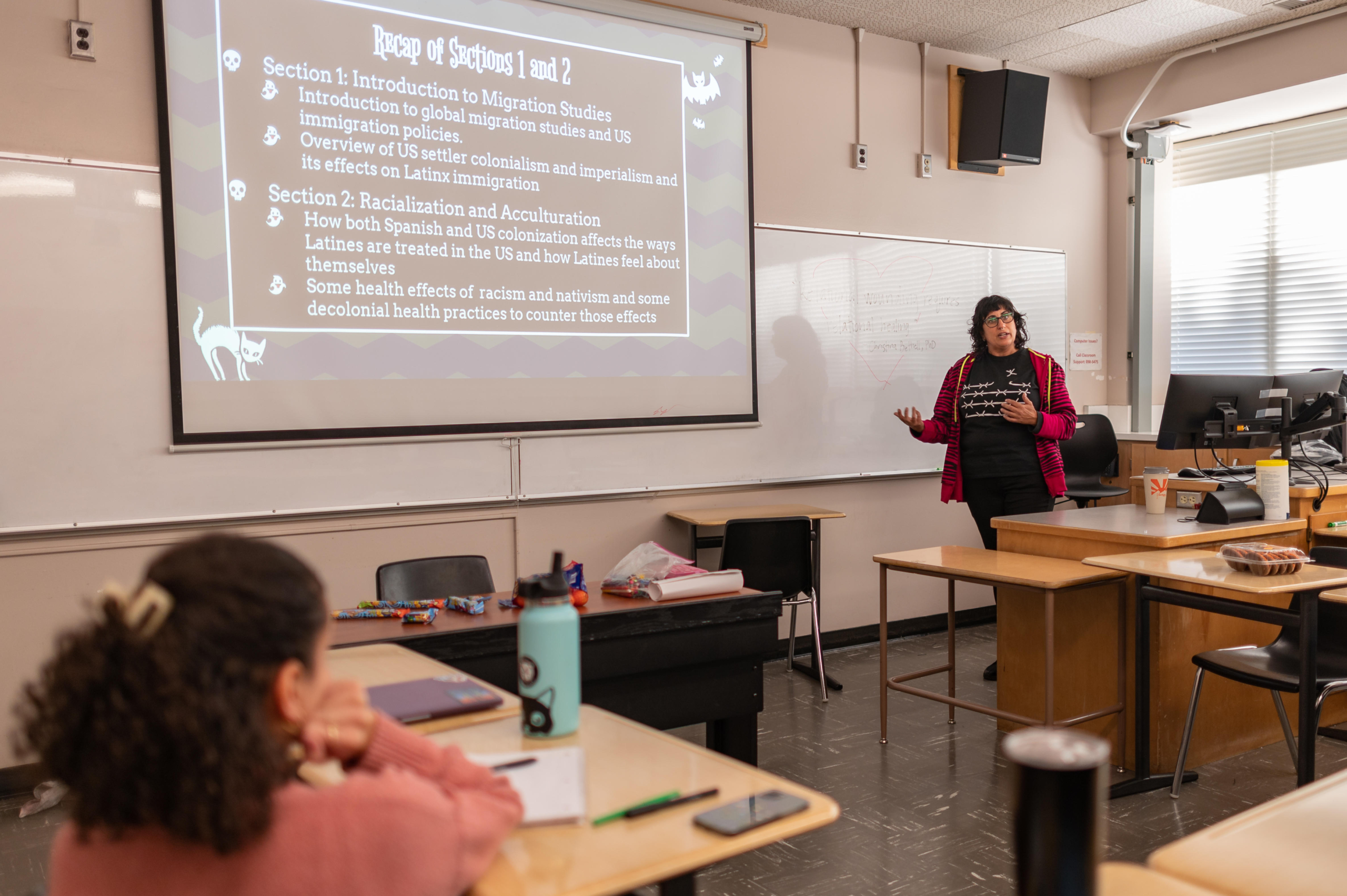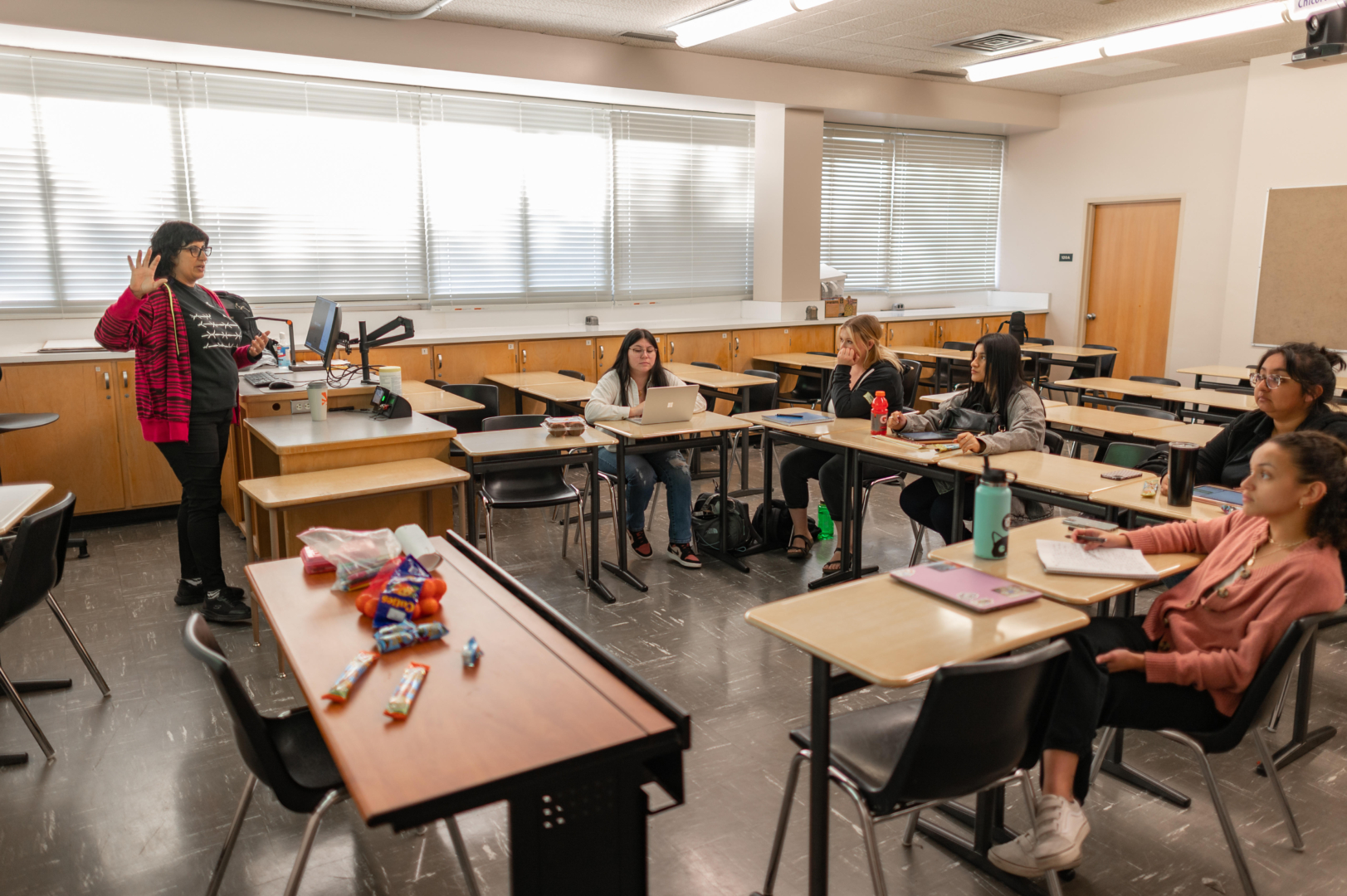‘Latinx and Immigration’ Class Dives Deeper into Lived Experiences

Assistant Professor of Black Studies and Latinx Studies Gabby Medina Falzone teaches Latinx and Immigration (CHLX 415) class on Wednesday, October 26, 2022 in Chico, Calif. This course on immigration is a social-historical examination of the migration and settlement of Mexican, Caribbean, South American and Central American origin people to the Unites States. (Matt Bates/University Photographer/Chico State)
When Gabby Medina Falzone stepped up to teach “Latinx and Immigration” an elective option for both the Intersectional Chicanx/Latinx major and minor, for the fall 2022 semester, she was ready to challenge her students and herself.
It was difficult, she admits, teaching a class that is regularly taught by a fellow faculty member, Paul Lopez, a long-time Chicano Studies scholar. With a solid foundation set, the course was highly relevant and impactful—and she envisioned adding her own twist to it while Lopez is on sabbatical this semester.
While this class has always centered on the complexities of Latinx immigration, Medina Falzone’s section explicitly focused on immigration through a critical Latinx studies (Latcrit) lens. Latcrit focuses on issues of power and dynamics and how they affect people—in this case, those who migrated from Latin America and those from the parts of Mexico that the US annexed. Latcrit is by nature intersectional, and this semester students explored the experiences of queer and trans people, youth and women, and cis women compared to cis men—an intersectional layer that opens the eyes of some of her students.
Medina Falzone also channeled her background in critical pedagogy to teach in a way that focused heavily on discussion, activities, and overall building a sense of class community.
“We’ve talked about some difficult concepts, both in terms of academic difficulty and in terms of emotional difficulty,” said Medina Falzone. “The conversations and the activities have been intense.”
Exploring theories of migration and settler colonialism in the US to racialization and economic exploitation, the class this semester began with a global and historical perspective and gradually narrowed in on the modern immigration experience, an approach Medina Falzone knows resonates with many Chico State students, particularly those who identify as Latinx/e/a/o or Hispanic—more than 36 percent of our students do—and those seeking to learn more about the journeys of their ancestors.

“I feel like this class is really helping students contextualize what their experiences are, because we often don’t get that sort of thing from our families,” she said. “My students certainly didn’t get in K–12 and they certainly didn’t get in any other class here at Chico State so far.”
Evelyn Xolalpa-Pablo, a third-year multicultural and gender studies (MCGS) major, said the class has helped cultivate an environment where she is learning about the history of her family, as well as the plight of others—and one in which she feels safe to speak freely.
“I can express my thoughts and feelings when speaking about difficult topics such as our immigration policies that affect a majority of the United States population,” she said. “Also, as someone who is Mexican, I don’t generally keep track of other countries’ situations, and this class has opened my eyes to the current conditions of some countries within Central America.”
Fourth-year multicultural and gender studies major Emily Cruz said the class has made her aware of the dangers that people from countries like Venezuela, Honduras, and many more are in—and that she explores these through a more critical lens.
“I had some initial knowledge about it, but this class really makes me think about how there are things bigger than myself,” she said.
For fourth-year Spanish and Chicanx/Latinx Studies double major Dania Mabiel Moreno Ruiz, who immigrated from Nicaragua eight years ago, the class content is more personal and poignant.
“I believe the Latine immigrant does not want to migrate to a different country, but the circumstances pretty much drive them to make this kind of decision,” she said. “Taking this class has made me feel validated as an immigrant.”
That’s exactly the kind of academic experience Medina Falzone aspired to see for her students.
“[My students] understand a little bit about their own migration history. But if there is something contentious or harmful in our culture, adults don’t want to discuss it with their children,” she said. “There’s a lot of intergenerational trauma that often goes unaddressed because we don’t know why something’s happening—we explore those types of themes in this class.”
As the semester winds down and Medina Falzone prepares to hand the class back over to Lopez, she is grateful for the opportunity to teach about such an important topic. For the class final, students are each writing an immigration policy proposal to address inequities in our immigration process. Seeing the topics that the students’ chose to address and how they chose to address them, Medina Falzone feels hopeful that these students have the skills to be the future change-makers this global society needs. She is excited to use her background in Latcrit and critical pedagogy to teach a special section of CHLX 358 focused on Latinx Health and Wellness next semester.
This semester, every student in the class were MCGS majors. Medina Falzone speculates this is because the class has a prerequisite of CHLX 157: “Introduction to Latinx Studies.” Now that CHLX 157 fulfills the new ethnic studies requirement implemented at all CSUs, Medina Falzone is hopeful more Latine students and allies will choose to take what they learned in that intro class and explore Latinx immigration at a deeper level.


